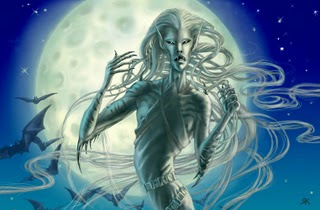| |
Banshee - Irish Fairy Unsolved Mysteries |
|
Source: http://www.irelandseye.com/animation/explorer/banshee.html
http://en.wikipedia.org/wiki/Banshee
 |
|
The bean-sidhe (woman of the fairy may be an ancestral spirit appointed to forewarn members of certain ancient Irish families of their time of death. According to tradition, the banshee can only cry for five major Irish families: the O'Neills, the O'Briens, the O'Connors, the O'Gradys and the Kavanaghs. Intermarriage has since extended this select list.
Whatever her origins, the banshee chiefly appears in one of three guises: a young woman, a stately matron or a raddled old hag. These represent the triple aspects of the Celtic goddess of war and death, namely Badhbh, Macha and Mor-Rioghain.)The Banshee She usually wears either a grey, hooded cloak or the winding sheet or grave robe of the unshriven dead. She may also appear as a washer-woman, and is seen apparently washing the blood stained clothes of those who are about to die. In this guise she is known as the bean-nighe (washing woman).
Although not always seen, her mourning call is heard, usually at night when someone is about to die. In 1437, King James I of Scotland was approached by an Irish seeress or banshee who foretold his murder at the instigation of the Earl of Atholl. This is an example of the banshee in human form. There are records of several human banshees or prophetesses attending the great houses of Ireland and the courts of local Irish kings. In some parts of Leinster, she is referred to as the bean chaointe (keening woman) whose wail can be so piercing that it shatters glass. In Kerry, the keen is experienced as a "low, pleasant singing"; in Tyrone as "the sound of two boards being struck together"; and on Rathlin Island as "a thin, screeching sound somewhere between the wail of a woman and the moan of an owl".
The banshee may also appear in a variety of other forms, such as that of a hooded crow, stoat, hare and weasel - animals associated in Ireland with witchcraft.
In Irish legend, a banshee wails nearby if someone is about to die. There are particular families who are believed to have banshees attached to them, and whose cries herald the death of a member of that family. The most common surname attached to the banshee was Mac. They were also associated with the Airlie clan. Accounts of banshees go back as far as 1380 with the publication of the Cathreim Thoirdhealbhaigh (Triumps of Torlough) by Seean mac Craith. Mentions of banshees can also be found in Norman literature of that time. The Ban Si was also known to wail at the crowning of the true king. Such a cry was reported to be heard at the crowning of Brian Boru. (a banshee is sometimes a cute woman or a old hag)
Traditionally, when a person died a woman would sing a lament at the funeral. These women are sometimes referred to as "keeners" and the best keeners would be in much demand. Legend has it that for five great Gaelic families — the O'Gradys, the O'Neills, the O'Briens, the O'Connors, and the Kavanaghs — the lament would be sung by a fairy woman; having foresight, she would sing the lament when a family member died, even if the person had died far away and news of their death had not yet come, so that the wailing of the banshee was the first warning the household had of the death.
The O'Briens' banshee was thought to have the name of Eevul, and was ruler of 25 other banshees who would always be at her attendance. It is thought that from this myth comes the idea that the wailing of numerous banshees signifies the death of a great person.
In later versions, the banshee might appear before the death and warn the family by wailing. When several banshees appeared at once, it indicated the death of someone great or holy. The tales sometimes recounted that the woman, though called a fairy, was a ghost, often of a specific murdered woman, or a woman who died in childbirth.
Banshees are frequently described as dressed in white or grey, often having long, pale hair which they brush with a silver comb, a detail scholar Patricia Lysaght attributes to confusion with local mermaid myths. This comb detail is also related to the centuries-old traditional romantic Irish story that, if you ever see a comb lying on the ground in Ireland, you must never pick it up, or the banshees (or mermaids — stories vary), having placed it there to lure unsuspecting humans, will spirit such gullible humans away. Other stories portray banshees as dressed in green, red, or black with a grey cloak.
Caspernia, The Friendly Banshee
A 'friendly Banshee' is one who in life, had strong ties to her family, and in death, felt the need to watch over them, and keep close to them. A friendly Banshee is not the horrible, scary thing we imagine. Banshees are rarely seen, but are said to at times show themselves. They are said to be seen as young, beautiful women, with pale faces, either black or golden hair, and long, flowing, white garments.
The song, because that is what it really is, of a friendly Banshee is sorrowful and longing. It is filled with love and concern for those she loves. It is a warning to her loved ones.
It is believed that a Banshee's song can be heard in the few days leading up to the death of a family member. The wails, or songs, are most often heard at night, and fairly often, the song is only heard by the one who the warning is intended for. A Banshee sings her song in warning to her family of the death of a beloved family member.

Submit News/Videos/Links |
Discuss article |
Article Link
|
More unsolved mysteries on Unexplained Mysteries
|


![]()